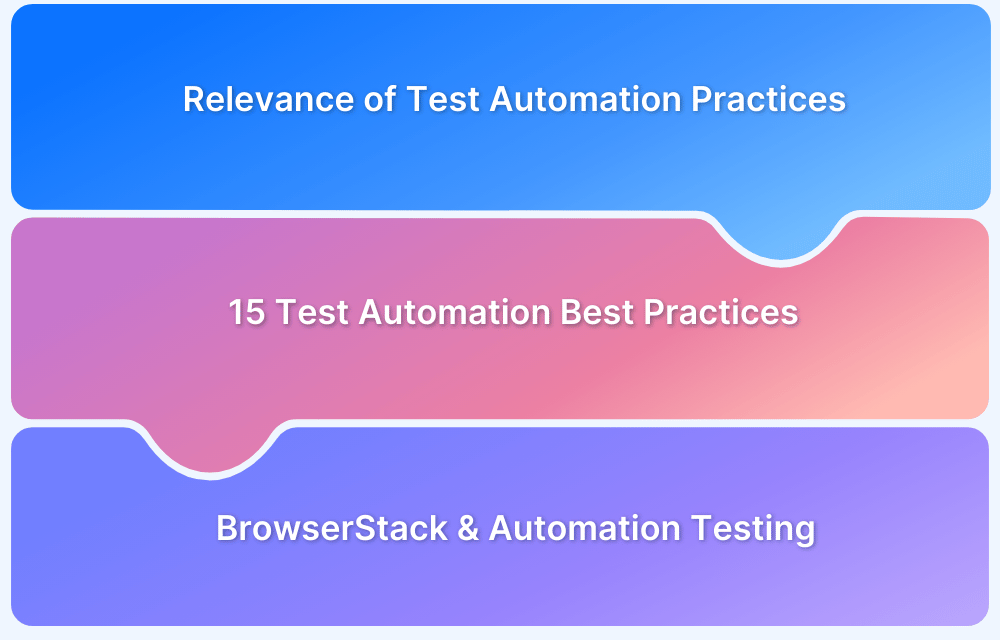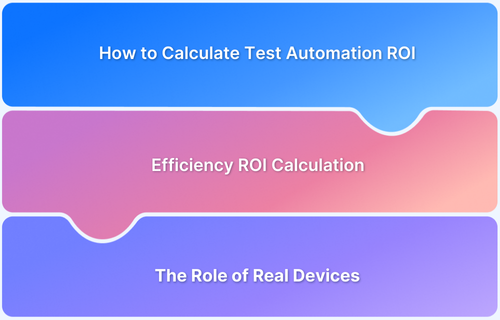As organizations increasingly rely on automation to improve efficiency, reduce errors, and streamline workflows, selecting the right tools becomes critical. By following a structured evaluation approach, decision-makers can ensure that the chosen tool not only meets immediate needs but also supports long-term business goals and growth.
Overview
Automation Tool Evaluation Checklist
- Is it within my Budget?
- Can your team effectively use the Test Automation Tool?
- What is the Tool’s Product Roadmap?
- Is the tool offering access to real browsers, and devices and operates for testing?
- Does the tool support the technologies already being used by your team/organization?
- Does the tool provide a robust reporting mechanism?
This checklist is designed to guide teams in systematically evaluating automation solutions against key criteria such as functionality, integration capabilities, scalability, usability, and cost-effectiveness.
What is Automation Tool Evaluation Checklist?
An automation tool evaluation checklist is a structured framework or guide used to assess, compare, and select the most suitable automation tools for an organization’s needs.
- It typically lists key criteria such as functionality, ease of use, integration with existing systems, scalability, vendor support, and cost.
- The checklist helps teams evaluate tools objectively, ensuring that the decision isn’t based only on hype, marketing claims, or personal bias.
- It can be applied across different automation categories — such as workflow automation, testing automation, RPA (Robotic Process Automation), or IT process automation.
Think of it as a decision-making aid that ensures all critical factors are considered before committing to a tool.
Benefits of Automation Tool Evaluation Checklist
Here are the benefits of automation tool evaluation checklist:
- Consistency in Decision-Making:Ensures all tools are judged against the same set of criteria, avoiding subjective or incomplete evaluations.
- Risk Reduction: Helps uncover potential limitations (e.g., lack of integrations or poor vendor support) before investing time and money.
- Efficiency in Selection: Saves time by providing a ready-to-use framework for evaluating multiple tools side by side.
- Alignment with Business Goals: Ensures the chosen automation tool supports organizational objectives, scalability needs, and compliance requirements.
- Cost Optimization: Avoids overspending on unnecessary features or hidden costs by comparing options more transparently.
In short: It exists to make sure you pick the right tool, for the right reasons, with the least risk.
Automation Tool Evaluation Checklist
This Automation Tool Evaluation Checklist provides a structured framework to assess tools systematically, ensuring the chosen solution aligns with business needs, technical requirements, and long-term goals:
1. Is it within my Budget?
Realistic financial concerns must always be the first considered. Before even deciding on what kind of tool you want to get started with test automation, be painfully aware of how much you are authorized to spend. Be aware that tools may entail licensing costs along with operational costs, maintenance costs, and sometimes, cost of support.
Additionally, factor in how much it would cost to train existing engineers in seamless and full-featured usage of the tool. You may purchase a highly sophisticated tool at a high cost (while still within the budget), but if the tool requires its users to be proficient in a programming language that your team is not comfortable with, you’ll have to spend far more to train them. This might result in going over budget and inviting the disapproval of management.
Read More: Calculating Test Automation ROI: A Guide
2. Can your team effectively use the Test Automation Tool?
Continuing from the previous point, this is something you have to be closely aware of. Designing effective, eloquent test scripts that ensure maximum test coverage is essential to fully leveraging the tool. This is only possible if the testers are already well-acquainted with the programming languages, techniques, and other skills required to navigate the tool and framework of choice.
Of course, you could always train your team in the skills required to obtain optimal benefits from the tool – and you probably will have to. But the possibility of that happening must be discussed with stakeholders and management before purchasing the tool, so that you get access to the resources required for setting up training within the stipulated time.
3. What is the Tool’s Product Roadmap?
Few things change as fast and as emphatically as our current technological landscape. Whatever tool you choose must have a history of upgrading periodically to support new technologies, innovations, and techniques. You may have to pay more to accommodate those upgrades, which is a budget consideration you have to note.
Once again, you might also have to spend to keep your team’s skills with every innovation, so don’t forget to account for those costs.
4. Is the tool offering access to real browsers, and devices and operates for testing?
Real device testing is not negotiable if you are looking for accurate, dependable results. You cannot get 100% correct test results from emulators and simulators because they are unable to replicate real user conditions to the full extent of the real world.
Therefore, unless you have an in-house device lab and the resources to maintain and update it every time a new device, browser/browser version, and OS/OS version hits the market, you’ll have to select a tool that offers access to a real device cloud. In both the long and short term, it is far easier and cheaper to use something like BrowserStack’s cloud-based test infrastructure that allows QAs to run manual and automated tests on 3000+ real browsers and devices at any time, from anywhere in the world. Simply sign up for free, choose the device-browser-OS combination you want to test on, run the necessary scripts and get completely accurate test results every time.
BrowserStack also provides integrations with a range of popular automation tools and frameworks to facilitate the process and make life easier for testers.
Run Automated Tests on Real Devices Free
5. Does the tool support the technologies already being used by your team/organization?
Remember that the tool must fit into your tech stack, not the other way around. Before making a purchase, be very clear about what other tools are being used on a regular basis in your team or company. Talk to developers across teams and make a comprehensive list. Once you have the list, check if the automation tools are compatible with them.
Even if the documentation claims to support your team’s existing tech ecosystem, download trial versions of the tools and verify it for yourself. Few things will cause you as much misery as buying a tool and realizing it does not align with the hardware-software setup that existing teams heavily depend on for daily tasks.
6. Does the tool meet your technical requirements/expectations – platform support, language support, support, usability, script reusability/maintainability?
A few common technical metrics to include in your Test Automation Framework Evaluation Criteria are:
- Platform: Which platform does the tool support – macOS, Linux, Windows, Unix, Mobile, Web? Frameworks like Selenium do have wider platform support, which is a major point in their favor.
- Programming & Scripting Languages: Which AUT programming languages does the tool support? Bear in mind that this might be different from scripting languages, which are required to actually write the test scripts. Again, the best tool will allow QAs to create test scripts in their preferred languages, reducing the time required to pick up a whole new language and get comfortable enough with it to write elegant, comprehensive tests (another point for Selenium!)
- Support: If you are using a new tool, you will inevitably require assistance, especially when getting acquainted with it. Check to verify if the tool comes with a robust and significantly-numbered community and/or a responsive, reliable, and active support function. Now, depending on the kind of tool, you might have to pay for support features such as access to a developer, response within a stipulated time, code review, etc. You will have to factor this into recurring costs. Additionally, if the tool has not posted new release notes, updates, or documentation recently, it is possible that they are no longer actively updating it, or that the community is inactive or less than active – both points against it.
- Usability: This concern has already been discussed above. You should be able to answer the question: Can my team effectively use the tool?
- Script Maintenance: For potent, successful, and repeatable automated tests, you need to maintain test scripts that can quickly reflect changes in test requirements. In agile pipelines, these changes occur often, and getting test scripts to adjust accordingly can be time-consuming and prone to error. Certain tools are able to do this automatically (usually only in part), which might be a very desirable quality to have in an automation tool.
- Data Sources: If you intend to have the keyword or data-driven automation frameworks, the testing tool you choose should be able to connect to and retrieve data from relevant sources. At the very least, this entails support for frequently used data sources such as Excel files, CSV files, various databases, XML files, etc.
- Record & Playback: This isn’t a mandatory feature, but having it would be a definite bonus. It makes the process of picking up the tool’s operation (for first-time users) easier, and also facilitates the faster creation of intelligent test scenarios.
Read More: Record and Playback in Selenium
7. Does the tool provide a robust reporting mechanism?
Automation testing is a massively collaborative exercise that requires multiple testers and sometimes teams to be simultaneously aware of multiple data points. For example, if a test fails, the team must be made immediately aware of that fact, as well as comprehensive reports of the environment and test conditions at the time of failure.
This requires detailed, meticulous reports of test results, especially that of exact the steps in which failures occur. Screenshots and snapshots of said steps are also especially helpful. Reports should be exportable in different formats so that stakeholders can view them conveniently. This is something else you should be checking when playing around with the trial versions of a tool.
BrowserStack provides a wide range of debugging tools for automated tests (both website & app testing) – Screenshots, Video Recording, Video-Log Sync, Text Logs, Network Logs, Selenium Logs, Console Logs, Appium Logs, Device Logs, and App Profiling for convenient data capture and reporting.
Make no mistake, creating an automated testing tool evaluation matrix, and using it effectively to select a tool that closely matches your automation goals will require time, effort, and possibly some frustrating dead ends. Use the pointers in this article as a launchpad, and build on them through discussions with and insights from all relevant stakeholders in your organization. Since automation is a common, almost mandatory feature of software testing pipelines, you can find expert advice with relatively low effort. Most importantly, bear in mind that finding the right tool will be worthy of all your efforts, and will almost definitely make your pipelines smarter and your life easier.






